|
Exhibition
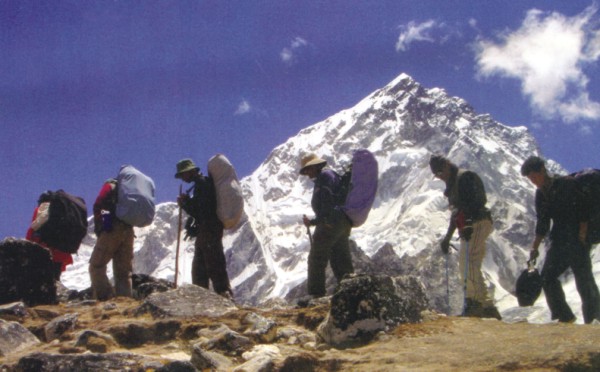
On
the way to the base camp by Enam Ul Haque.
Braving
the Heights
Mustafa
Zaman
When
the six-member mountaineering team was trudging the trail
to the "base camp" of the Mount Everest, it was
recognised by most other teams. Not because the team was the
first from Bangladesh to prepare for summit, but because Kalidas
Karmaker, a renowned artist and an extra team member, had
publicised its attempt to climb the base camp beforehand.
He plastered flyers on the walls of the lodges where trekkers
stay overnight on their way up.
It
was during the month of May that the team of six with an ambition
to make it to the Everest spent 13 days on the trail -- the
much-known international route to the base camp. The trekkers,
seasoned through numerous journeying in the mountain ranges
of Bangladesh as well as a number of trips to Nepal, attempted
the journey as part of the preparition for the conquest of
the Mount Everest. As for the artist who tagged along, he
had little experience compared to the other team members.
In the team, one exceptional member was GQ Chowdhury. At 64,
his enthusiasm was perpetual.
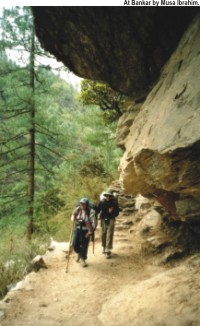 Old
or young, they were drawn by the beauty of the mountain ranges
and wanted to see how they fared alongside professional mountaineers.
Enam Ul Haque, M A Mohit, Musa Ibrahim, Kazi Samsuzzaman and
Sadia Sultana had to attempt this climb to 17000 altitude
as part of their training. The team went out to conquer the
base camp under the aegis of Haque, a seasoned trekker and
nature enthusiast. Other than Chowdhury the rest of the team
consisted of four young enthusiasts who had their eyes set
on the highest peak. In line with their ambition, they had
already gone through the first phase of their training at
institutions in India, where they successfully completed the
foundation course in mountaineering in March. Making it to
the base camp was the second phase of their training. Old
or young, they were drawn by the beauty of the mountain ranges
and wanted to see how they fared alongside professional mountaineers.
Enam Ul Haque, M A Mohit, Musa Ibrahim, Kazi Samsuzzaman and
Sadia Sultana had to attempt this climb to 17000 altitude
as part of their training. The team went out to conquer the
base camp under the aegis of Haque, a seasoned trekker and
nature enthusiast. Other than Chowdhury the rest of the team
consisted of four young enthusiasts who had their eyes set
on the highest peak. In line with their ambition, they had
already gone through the first phase of their training at
institutions in India, where they successfully completed the
foundation course in mountaineering in March. Making it to
the base camp was the second phase of their training.
"It
is a trial in body fitness, a way to find out how you fare
while standing on a foothill of the Himalayas that is 17000
feet above sea level," Musa explains. The base camp,
from where the would-be summiters start the climb to the highest
peak, is where one must climb first to acclimatise themselves
before they prepare for the big one.
For
the Bangladeshi climbers the journey to the Everest base camp
was simply a continuation of their training. Although Kalidas
could not make it to the base camp, he climbed up to Namchi
Bazar -- the highest town, known as the gateway to the Everest.
It is also known as Sherpa capital, as its inhabitants are
predominantly of this profession.
For
the Bangladeshi team led by Haque, everything went smoothly
during the 13 days on trail. They were faced with bad weather
at the last phase of their climb and were robbed of one day.
At no point in their journey did they feel any compulsion
to rush things. "We did not hurry, as we had Chowdhury
and Kali Da (Kalidas Karmakar) with us. We too also wanted
to take things slowly as it was our first attempt," says
Sadia Sultana, the only woman participant from Bangladesh.
"Any
trail has a lot of interesting aspects to it and the trail we
followed to the base camp is an international route and in May
you are never alone," Ibrahim proclaims. They went closer
to Kala Patthar, the 18000 feet rocky black peak close to the
Everest.
"I trekked the Himalayan
trail before, but in May in this particular trail, the villages
were teeming with mountaineers from all over the world. It
was an opportunity to interact with Sherpas," says Sultana,
whose enthusiasm for climbing did not even escape the notice
of foreign summiters.
"While on the trail,
we got to meet a lot of climbers. On one occasion, a European
trekker complimented me by saying that I was a quick walker.
It was not until we were at the airport ready to take off
for home that the man told me he was a summiter," Sultana
says.
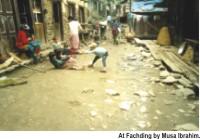 The
thrill of the journey on such a trail is not only about making
it to the destination but also about meeting people. "While
on a trail, all the other trekkers consider you as friends.
They pass you tips pertaining to the journey. Even those who
failed and are returning on horseback will leave you with notes
of precautions, provide you dos and don'ts," says Ibrahim,
who was happy to observe that as Bangladeshis they received
special treatment from the Nepalese. The
thrill of the journey on such a trail is not only about making
it to the destination but also about meeting people. "While
on a trail, all the other trekkers consider you as friends.
They pass you tips pertaining to the journey. Even those who
failed and are returning on horseback will leave you with notes
of precautions, provide you dos and don'ts," says Ibrahim,
who was happy to observe that as Bangladeshis they received
special treatment from the Nepalese.
"Food is really expensive in Nepal,
and even boiled water is sold. The minute our hosts realised
that we were Bangladeshis, they started treating us well.
Some even made the boiled water free," Ibrahim adds.
The younger team members were a bit
apprehensive of their adventure. Only Samsuzzaman and Mohit
had prior experience to climb to similar heights at which
the base camp rests. The hospitality of the hosts made things
easier.
Many other Bangladeshis have reached
the base camp prior to this group. But they were travellers
who just happened to respond to the temptation to taking a
closer look at the magnificent mountain ranges that is the
Himalayas. As for the members of this group, it was part of
the preparatory training that they had to go through before
attempting to conquer the summit.
The team left Gorokshep, the last locality
where one can stay overnight and treat oneself to all sorts
of Nepalese delicacies. Their final destination was ahead
of them. " It was a steep ride through a gravel-filled
trail in some areas and on glacier in others," Ibrahim
recaptures their ordeal.
Once
they reached the Everest base camp and were pitching their
tents, they knew that they would be the first team from Bangladesh
to camp their with an aspiration to climb the Everest.
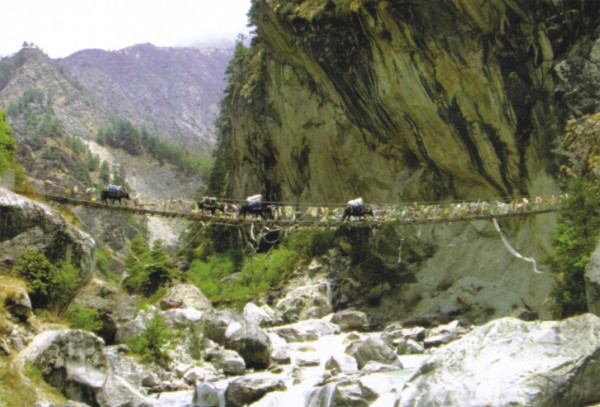
A
rope way on the trail by Enamul Haque.
To
encapsulate the journey in images the mountaineers kept clicking
their cameras, which in the end resulted in a photography
show. Enam Ul Haque, along with three other mountaineers Mohit,
Ibrahim and Sultana, arranged for an exhibition of photographs
they had taken while on their trail.
"We planned it as a virtual tour
for the viewers," exclaims Ibrahim. Mountaineering is
a life-style that has all sorts of technicalities attached
to it, but it also has a human aspect to it. The place and
the people that were featured in the photography exhibition
bring this to the fore. The show had ample evidence of how
Haque and his young compatriots observed the localities that
they passed through on their trail. There were pictures of
Sherpa families that show how the mountaineers had developed
interest in interacting with people they met on their way.
It is through the photographs that the people of Dhaka got
glimpses of the Himalayan mountain ranges and its localities.
One of the team members Kazi Samsuzzaman had a solo exhibition
at Zainul Gallery and now at Drik from August 28 to September
1, 2004 the four have a chance to amass a crop of their yields.
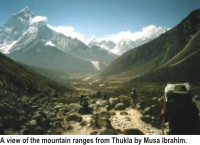 Haque
is already known as a nature photographer; next to his images
the photographs of the three young mountaineers fare well.
They too vie for attention. Concerning the nature of the exhibition,
Ibrahim and Sultana came up with a disclaimer. They are unanimous
that it is not so much as an effort to capture the beauty
that inspired them. It was rather an attempt to keep a record
of the entire journey. Haque
is already known as a nature photographer; next to his images
the photographs of the three young mountaineers fare well.
They too vie for attention. Concerning the nature of the exhibition,
Ibrahim and Sultana came up with a disclaimer. They are unanimous
that it is not so much as an effort to capture the beauty
that inspired them. It was rather an attempt to keep a record
of the entire journey.
Many trekkers fail to
reach even the base camp; few even die each year. Yet the
flow of climbers is ceaseless. As for the Bangladeshi team,
they made it to the base camp and came back with an array
of visual records. The photographic document may not show
much sign of the ordeal that the climbers face. That reality
certainly gets lost in the scenic beauty. "We were cautioned
by our trainers at the institutions that the place we fall
ill would be the place we must call it off," says Ibrahim.
"A Japanese couple we befriended and often met during
the first phase of our journey had to stop climbing as the
husband fell ill," adds Sultana. These experiences the
trekkers did not record, while taking photos they focused
on the journey they went through. After all, it was to successfully
reach the Everest base camp that the team members strove for.
In the base camp overlooking the Khumbu
glacier, the Bangladeshi explorers met summiters returning
after making it to the top of the glacier. They all were catalysed
to cross that line from where the final phase of the ascent
begins.

Wife
and son of a Sherpa by M A Mohit.
"To cross that line you will have
to pay 50,000 dollars even after you acquire the permission
after going through all the preparatory phases," says
Ibrahim. Getting the final green light to climb the Everest
is a tough hurdle. However, Mount Everest keeps attracting
mountaineers from around the globe even 41 years after Hillary
and Tenzing first set foot on it. To understand the strong
temptation, Musa Ibrahim provides us with a handle, he says,
"From the base camp I could see the mountaineers walking
on Khumbu glacier. I felt so excited that it made me want
to start climbing."
They reached the base camp, from where
the Everest peak is only 12000 feet away. The lure keeps them
going through tough physical training. They have already completed
the basic course in mountaineering, now they are set to do
the advance course in the next few months. The photos that
they brought in from their expedition serve to brush off their
enthusiasm on the viewers.
Copyright
(R) thedailystar.net 2004
|
